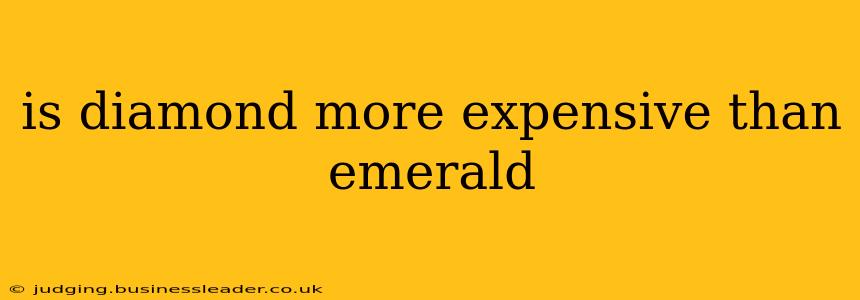Is Diamond More Expensive Than Emerald? A Deep Dive into Gemstone Value
The question of whether diamonds are more expensive than emeralds doesn't have a simple yes or no answer. While diamonds are often perceived as the most expensive gemstone, the price of both diamonds and emeralds varies significantly depending on several crucial factors. Let's explore these factors to understand the complexities of gemstone valuation.
What Factors Determine Diamond Price?
Several interconnected factors influence a diamond's price, collectively known as the "4Cs":
-
Cut: This refers to how well a diamond's facets interact with light, impacting its brilliance, fire, and scintillation. An expertly cut diamond will command a higher price than a poorly cut one, even if they have the same carat weight and clarity.
-
Clarity: This describes the absence of inclusions (internal flaws) and blemishes (external flaws) in a diamond. Flawless diamonds are exceedingly rare and consequently, more expensive.
-
Carat: This refers to a diamond's weight, with one carat equaling 200 milligrams. Larger diamonds are generally more valuable, though the other 3Cs significantly impact the price per carat.
-
Color: Diamonds range from colorless (most valuable) to yellow, brown, or other colors. Colorless diamonds are highly prized, while fancy colored diamonds (like blue or pink) can command exceptionally high prices.
What Factors Determine Emerald Price?
Emeralds, like diamonds, also have key factors determining their price:
-
Color: The most crucial factor for emeralds is their color. Intense, vivid green is most desirable. Variations in hue, saturation, and tone dramatically affect price.
-
Clarity: Emeralds are notoriously included, meaning they often have many internal flaws (inclusions). While some inclusions are visible to the naked eye, they are often accepted as part of the stone's character. However, the fewer and less noticeable the inclusions, the higher the price.
-
Cut: Similar to diamonds, the cut of an emerald influences its brilliance and overall appearance. Well-cut emeralds maximize their color and brilliance.
-
Carat Weight: Larger, high-quality emeralds are rarer and more expensive than smaller ones.
Can an Emerald Be More Expensive Than a Diamond?
Yes, absolutely. A high-quality, large, intensely colored emerald with minimal inclusions can easily surpass the price of a diamond of comparable size. Conversely, a small, low-clarity diamond might be less expensive than a smaller, high-quality emerald. The price difference often depends on the specific characteristics of each stone.
Which is More Valuable?
There's no single answer. The value of both emeralds and diamonds is determined by a complex interplay of factors. While diamonds often hold a higher perceived value due to extensive marketing, a specific exceptional emerald can easily outshine a diamond in price.
What About Other Factors Affecting Price?
Beyond the inherent qualities of the stones themselves, several additional factors affect their price:
-
Treatment: Both diamonds and emeralds can undergo treatments to enhance their appearance. These treatments can affect their value, sometimes negatively.
-
Origin: The origin of a gemstone can also influence its price. Certain mines are known for producing higher-quality stones.
-
Market Demand: Like any commodity, the supply and demand for a particular type of gemstone can affect its price.
In Conclusion:
Ultimately, whether a diamond or emerald is more expensive depends on the specific characteristics of each stone. It's crucial to consider the 4Cs (for diamonds) and the key characteristics mentioned above for emeralds to understand their relative value. A professional gemologist can provide an accurate appraisal based on these factors.
